Was interviewed the other day by the US based USA Prepares Show (https://www.youtube.com/watch?v=Z8W5SjHRHVI)
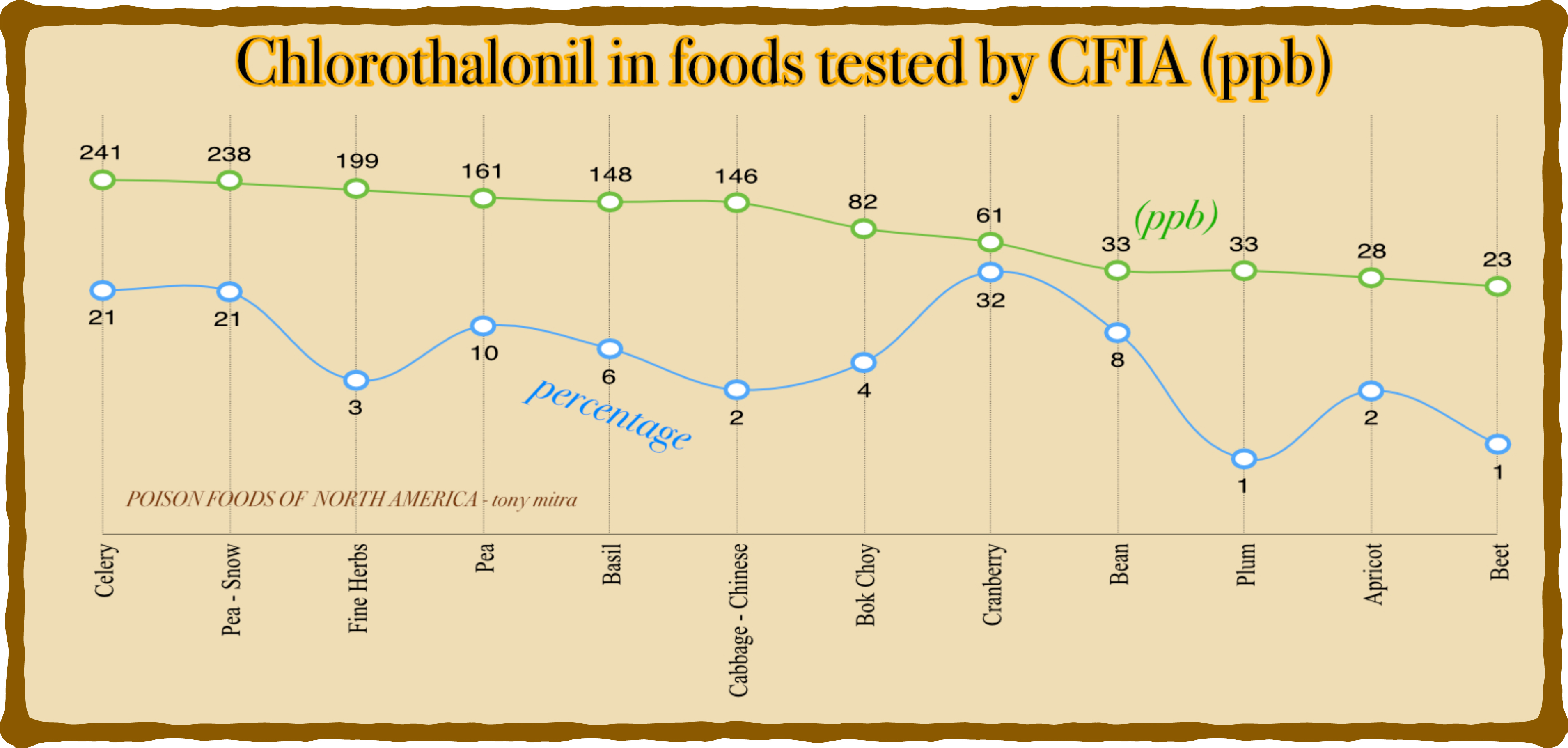

Was interviewed the other day by the US based USA Prepares Show (https://www.youtube.com/watch?v=Z8W5SjHRHVI)

Foods tested for glyphosate, and also foods tested for 2,4-D total over 15,000 records. The chart below gives a brief overall readings of some food types that were noted to have both glyphosate as well as 2,4-D though not necessarily from the same sample or the same sample lot. Also, the graph is not region specific and covers a global average.
More specific details will follow.
The readings for glyphosate, in blue have a much higher level of concentration compared to 2,4-D, in green, the chart was drawn on logarithmic scale rather than linear scale, to bring the two curves closer to each other, so a visual comparison and perspective could be drawn. The chart was sorted with the 2,4-D readings in ascending order from left to right i the green curve, with corresponding glyphosate readings plotted in blue for each food type. Those foods that did not have value for both chemicals have been omitted. The chart only shows average concentration of the toxins. It does not show umber of samples for each type, nor the percentage of samples that were dirty or the lower and higher extreme readings in each group.

I am determined to try my best to bring the issue of glyphosate and the Canadian Foods being the most toxic on earth, to the mainstream political discourse. I have not been too successful so far, as politicians in general as well as mainstream media, seems to have developed a case of indigestion when it comes to facing this issue.
Nonetheless, the effort continues, as part of our citizen’s duty, to be vigorously involved in our political process and try to force the candidates to address real concerns of citizens intend of talking on manufactured issues.
I have already written to three candidates of my riding, cover in earlier blogs. These were from the Liberal, NDP and BC Greens party. Two of them, the Liberal and the NDP, did not even bother to respond, which has convinced me never to vote for a candidate that ignores you.
But more than that, I have tried to lead by example so other citizens would follow and try to ask direct questions to the candidates, especially why people of western Canada are subjected to the most toxic foods on earth.
I made a few videos on this already.
The first one is here – a ten minute video about why and how I found Western Canada to be the epicentre of toxic foods.
The next, my explanation on why I wrote the book on glyphosate contamination of foods based on CFIA records, and why I do not go with the mainstream media trying to whitewash the results – an 8 minute video.
Next, a letter to the BC Greens Leader. – a 3 minute video.
And finally, a response from the BC Greens candidate from my riding – another under 3 minute video.
As I was telling someone in email today, I am convinced that our problem is rooted more to the corruption in my political process and less to do with Monsanto or any other entity, and it is our duty, as a citizen, to grab this political beast by the horn and shake it till it starts piddling.
Stay tuned.

Jacqui Miller – Greens Candidate

Scott Hamilton – Liberal incumbent

Ravi Kahlon, NDP Candidate

I self published the book ‘Poison Foods of North America‘ late in March 2017, covering my analysis of near 8,000 records of foods tested by the Canadian Food Inspection Agency, on presence of Glyphosate in food.
Meanwhile, I believe CFIA has come out with a report on its findings.
And now, I am told by friends that lots of folks are making lots of posts on the web here and there, about it, and I am told most of these reports might be projecting a different view and that the CFIA report appears to make my book look bad.
Well, I do not believe CFIA report will be in contradiction of my analysis, since we are both presumably looking at the same data. However, I fully expect our government to project an interpretation of the records so as to project an image that Canadian foods are fine. I expect it to highlight what might appear to look good, and not highlight things that are uncomfortable to talk about for a government.
The reason I wrote the book is completely different. I found alarming facts in the records, starting with
So, this book for those that wish to have a tool to navigate their way through this toxic mine field in our food web. This book is for those that have already made up their mind that glyphosate is a seriously harmful weed killing chemical to be in their food.
This book is not for discussing philosophy of poisons in foods. For those that wish to engage in philosophical discussions, they may find other places to engage in exchanging views.
Philosophy is good. But my book is not about philosophy. The attached seven minute video explains the same in my own voice.
Thanks.
 https://www.amazon.ca/POISON-FOODS-NORTH-AMERICA-navigating-ebook/dp/B06XS4Y6H2/ref=sr_1_1?ie=UTF8&qid=1491597662&sr=8-1&keywords=poison+foods+of+north+america
https://www.amazon.ca/POISON-FOODS-NORTH-AMERICA-navigating-ebook/dp/B06XS4Y6H2/ref=sr_1_1?ie=UTF8&qid=1491597662&sr=8-1&keywords=poison+foods+of+north+america
A letter sent
To: Mr. Tom Mulcair,

Tom Mulcair, NDP leader

Toxicity in North American foods compared to the rest of the world

Ravi Kahlon – NDP candidate

Canadian rye the most toxic on earth

Scott Hamilton, incumbent MLA, Liberal
I believe glyphosate will go down in history as the worst synthetic chemical this planet has ever faced, as a consequence of its perceived non-toxicity to humans and its massive use in agriculture and on people’s lawns with careless handling due to lack of awareness of its insidious, cumulative toxicity. It is destructive of human health and it is threatening extinction to multiple species, most obviously the bees and the monarch butterflies. I believe it will eventually be proven that glyphosate gets into proteins by mistake in place of glycine, and that this is the key reason for several phenomena going on in the US (and Canada?) that currently are seemingly inexplicable:
Collagen makes up 25% of the body’s protein, and glycine makes up 25% of collagen’s amino acids. Collagen in pigs and cows fed heavy doses of glyphosate in their feed is the main source of gelatin that makes its way into vaccines, gel caps, jello, and various other food products. Collagen is contaminated with glyphosate and as a consequence so are these derivatives. This easily explains why MMR vaccine today causes many more acute adverse reactions than it did in the 1990’s.
This book by Tony Mitra is priceless because it tells you which foods have the highest contamination of glyphosate, so you can change your eating habits to minimize your exposure. Glyphosate needs to be banned immediately across the globe, if we are to preserve a bright future for our children and grandchildren.
“Poison Foods of North America” provides critical information for all healthy, health conscience, infirm and struggling individuals that is necessary to prevent the deterioration in their and their families health as a result of the betrayal of the public trust that was placed in regulatory bodies.
Future historians may well look back upon our time and write, not about how many pounds of pesticides we did or did not apply, but about how willing we are to sacrifice our children and jeopardize future generations based on flawed science and failed promises just to benefit the bottom line of a commercial enterprise.
(Le français suit l’anglais) Thank you for contacting our office. All messages are read and considered. However, due to the high volume of emails received, it may not be possible to respond personally to each one. Please visit our website (http://www.ndp.ca) to learn more about our NDP team (http://www.ndp.ca/team) and latest news (http://www.ndp.ca/news). Thank you again for taking the time to share your ideas, concerns and insights. Your input helps us with our work. All the best, Office of Tom Mulcair, MP (Outremont) Leader, New Democratic Party
A question asked of the election candidates of my riding
Glyphosate has been in the public eye for a while now. I hear that in California, a court has mandated that Roundup herbicide must have a comment in the label that it likely is carcinogenic, or can cause cancer.
 There is further news coming from some reportedly leaked comments from within US-EPA that the manner in which glyphosate safety test documents and data has been accepted has apparently not gone well with everyone in EPA. Well, it is almost 40 years since glyphosate has been unleashed. It is high time that approval of glyphosate was put under scrutiny.
There is further news coming from some reportedly leaked comments from within US-EPA that the manner in which glyphosate safety test documents and data has been accepted has apparently not gone well with everyone in EPA. Well, it is almost 40 years since glyphosate has been unleashed. It is high time that approval of glyphosate was put under scrutiny.
In Canada, the EPA counter part, Health Canada, has never released all the safety documents and data based on which it approved glyphosate for use in agriculture. According to my understanding of the law, it is illegal to approve and allow release of a product while withholding release of its safety data. I have had multi-year running issues with the government trying to get disclosure of these safety records.
It is because of these reasons that I do not accept the government set safe limits (MRL) of glyphosate in food. One cannot accept 5,000 ppb of glyphosate in wheat, when the government has not shown proof that glyphosate is safe even at 1 ppb.
Meanwhile, after some years of butting heads with the government on a related issue of Canada not having labs that could test glyphosate in food, and after WHO declared glyphosate to be a probable carcinogen, thankfully the Government showed some inclination to test foods for glyphosate, but on the quiet and away from mainstream media glare.
By the summer of 2015, there were indications from labs that they were busy handling lots of orders from Ottawa in testing glyphosate in all kinds of food samples.
I had by then already been asking Health Canada, Agriculture Canada and Canadian Food Inspection Agency, for letting me have results of all foods tested in Canada for glyphosate. Finally, in December 2016, I got over 7,800 records of foods tested for glyphosate and its metabolite AMPA under order of CFIA.
The records involved more than five thousand samples and at times multiple records on each samples involving glyphosate and/or AMPA content. Samples were all collected from within Canada, but represented both locally grown and imported food. Foods from more than sixty countries had been collected and tested.
Attempt was initiated immediately, convert the data into an usable format and to analyze it and advise the people on which kinds of foods had how much glyphosate. Scanned images of pages of those records were converted using OCR software, error corrected and turned into electronic data that could be sorted, tabulated, and used for analysis
Same was done over the next few months. The results have in some cases been as expected and in other cases, totally surprising.
A few things became clear as more and more data were analyzed. For example, crops that were not genetically modified but were grown in an industrial scale in north America and were desiccated with glyphosate, had very much more glyphosate in them, than genetically modified Roundup Ready crops.
Another shocking realization was, Canada and the US were producers of the most toxic food in the planet. The difference was not even marginal. Canadian and American grown foods, especially those conventional non GM crops that used glyphosate as a pre-harvest desiccant, had an order of dimension greater level of glyphosate poison in them than the same crops grown anywhere else.
Since I have reason to doubt the Government set MRL while safety data is kept out of reach of people, I consider any level of glyphosate concentration to be poisonous – acutely poisonous to a large body of beneficial organisms and a chronic poison for all other creatures of value including ourselves.
And so, finally, the e-book was prepared and placed on line with Amazon.
This book is not designed to join a debate on if glyphosate is safe or unsafe to be in food or at what level it might be dangerous. This book is for those people that have already decided that glyphosate is an undesirable chemical that can cause serious harm even if taken in low doses over time. It is for those people that are looking for a tool to help navigate through this glyphosate minefield of North American food system.
The book will continue to be edited and more material added. Legal owners will get free downloads of all updates on it. The book is currently over 220 pages long on an iPad and over thousand pages long on a smart phone, as indicated through Amazon upload, though I have not checked it with my iPad or iPhone yet.
Analysis of near 8000 records of foods collected and tested in Canada that originated in over 60 countries, for glyphosate content, between mid 2015 and end 2016 by Canadian Food Inspection Agency (CFIA).
North American foods are most heavily contaminated by glyphosate, the active ingredient in Roundup weed killer. This book is for those people who do not look for continued debate on safety levels of glyphosate, and have already decided that glyphosate is an undesirable chemical to be in their food, and merely wish to have a tool with which they could try and avoid eating foods that have high glyphosate content.
The book has over 220 pages, 55,000 words, filled with over 250 tables along with charts and images. The data is sorted in chapters, starting with the Maximum Residue Limit (MRL) set by the government, comparison of glyphosate in food according to country of origin, and checking according to food types, such as grains, beans, flour, lentils, fruits, vegetables, and ready made meals. Under wheats, sub-sections check wheat bran, wheat flour, wheat germ, whole wheat, pasta, pizza, baking mix, couscous. It shows how glyphosate contamination of bran in wheat grown in Canada averages at over 2,000 ppb, or how 96% of all Canadian wheat bran tested were contaminated against 78% of the US wheat bran. It gives some of the worse contaminations of individual samples in separate tables, with contaminations between 4,000 and 7,000 ppb and how some of them are in violation of the MRL set by the government.
There are specific chapters on organic foods or gluten free ones, and tables comparing where eating organic ensures lower glyphosate contamination and where it does not ensure that. It shows which foods are free of glyphosate irrespective of being organic or not.
Glyphosate (RoundUp) has been in our farms and fields for a generation. That it is safe for humans is supposed to have been verified by the Government. Yet, the documents containing tests done on animals that prove that it does not affect mammals, or beneficial insects such as worms, bees, our gut micro-biome and the flora and fauna of the land, have been kept out of reach from the people.
My understanding of the law is – if the safety documents of a product cannot be released to the people, then the product itself may not be approved for release. While the Government is not saying people do not have right to see the documents, these data are one way or another kept out of reach of the people, often using arguments that the promoter of the product has patents and intellectual rights, and there is a confidentiality clause attached to the agreement with the Government.
This book is not aimed to join the debate on if glyphosate is safe and at what level of contamination it might be a concern. Rather, this book is designed for those people that have already decided to actively try and avoid having glyphosate in their food. This book is to help them select what kind of food, grown in which countries might be better or worse.
Canadian and US foods are about the most contaminated in the entire planet, and finding clean food free of glyphosate has gotten a major challenge, as the data shown in this book will indicate. Navigating through this glyphosate mine field may be of paramount importance for discerning people that are already conscious of potential health issues related to consuming a continuous dose of glyphosate over a long period.
I believe, without bias, that this book is the best guide and tool for consumers, especially those living in North America or considering imported foods from North America, to avoid a steady dose of slow poisoning through glyphosate. I believe this is the only one of its kind. There is no other.
I have more or less cleaned up the 7,800 odd records received from CFIA on foods tested for glyphosate. That has brought me to study wheat products to greater detail, because wheat is regularly desiccated with glyphosate in North America and is a suspect crop to contain high glyphosate. The results of the investigation, described below, has helped me prepare two graphs. The first one is below, Graph-1, is a line diagram of average glyphosate (& AMPA) content in wheat subgroups. You can see how the figure for wheat bran goes through the roof.
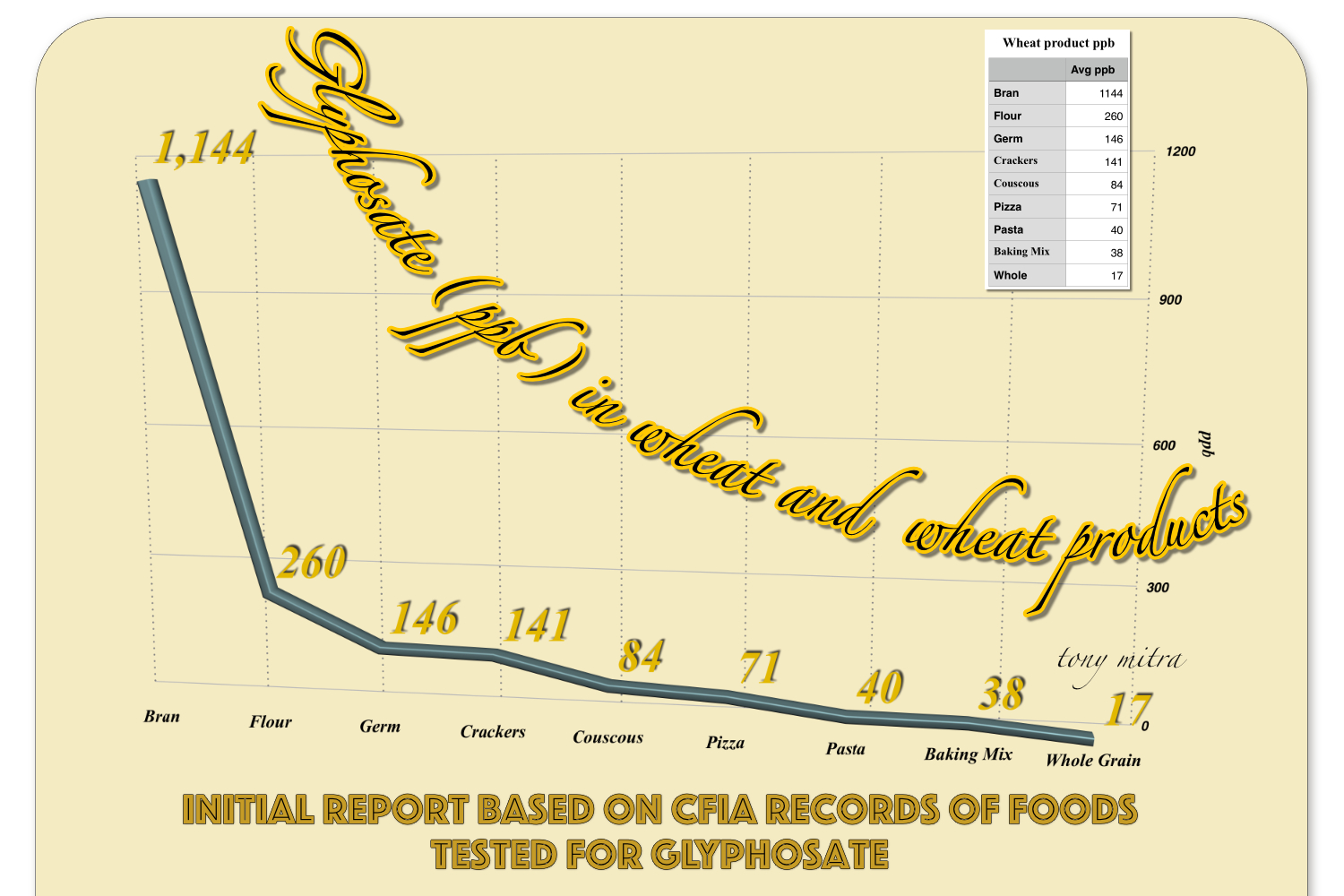
Graph 1
Then there is the issue of other subgroups. Although their average content appears relatively low, the view of this presenter, (tony mitra) is that no glyphosate is good glyphosate and that standard toxicology tests for glyphosate is insufficient an yardstick for assessing safety limits of glyphosate. Therefore, preference is to have no glyphosate at all. Further, effort is made here to check how many of the samples of each subgroup contain glyphosate, and for that figure, apart from average ppb limits, to be as relevant an indication. To that end, the second graph (#2) was prepared, based on below Table-D. The picture is not pretty.
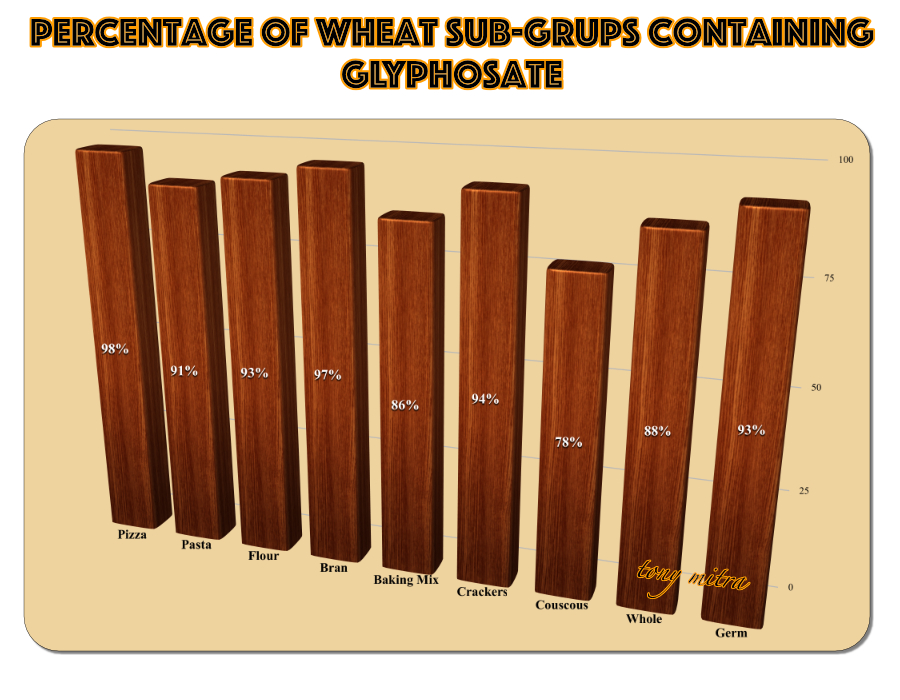
Graph 2
A few unanswered question remain. These are:
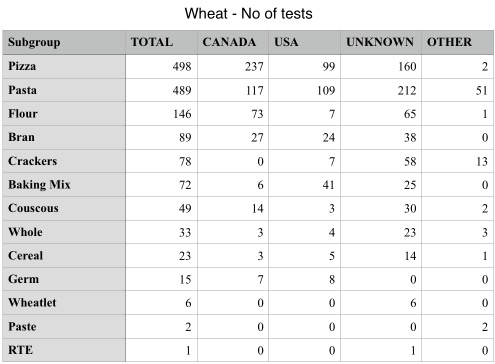
Table-A
Table-A gives the number of tests done on wheat, broken down into some of the common subgroups. More than a thousand tests are represented in the above table. Some of the readings may not be fully correct, such as RTE (ready to eat – meals) since the description of the item is not too indicative if wheat is an ingredient or not. However, for the rest of the groups, the numbers should be more representative.
The fact that “unknown” Category represents such a large volume of tests has been a source of vexation for me. I suspect these are likely almost all of Canadian origin, though perhaps procured in bulk without a container or a label marking the country of origin, and hence entered as unknown by the CFIA staff. Therefore, to make better sense of the breakdown based on regions, I am going to place unknown together with Canada and call it Canada+ in these studies.
Regarding other regions away from North America, only one subgroup item, Pasta, has a reasonable number (51). So that one might be analyzed to see if Pasta coming from overseas is any better than local produce. That is not yet covered in this blog.
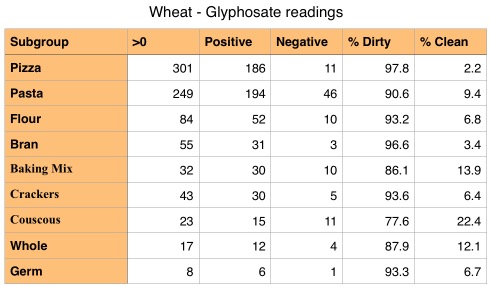
Table-B
Table-B shows how man of the tests for some of the subgroups had a reading above zero, how many of the screenings showed positive, how many negative, and the percentages of clean and dirty results. Since I assume (to be confirmed) that the ‘positive’ results of the more economical ‘glyphosate screening’ tests have been followed up with further and more expensive tests for the concentration, these were ignored, while the negative results where counted, for the percentages. Thus, the total number of samples were those of the first (>0) and third (negative) column. Thus, the percentage of dirty samples for pizza would represent the ration of 301 to (301+11), or 97.8%. This too might alter a bit after cross checking ore details from CFIA, especially about AMPA readings.
However, one can already guess that the general readings for wheat products are really bad with regard to glyphosate contamination.
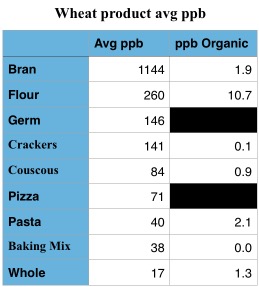
Table-C
Then comes the next table, Table-C, at left, with blue headers. This gives the average ppb figures of glyphosate (& AMPA) for each subgroup. As you can see, the numbers for Wheat Bran has gone through the roof. I should be checking with some experts on this, but suspect the reason for this to be that the best sink for the desiccated glyphosate is the outer layer of the wheat, i.e. the bran, and thus it is here that most of the glyphosate resides. The numbers fall off sharply in flour and germ. I am a bit puzzled by the reasonably low figure of whole wheat grains (bottom most item), and wonder if that because it includes items that are not really whole grain, but misrepresented or misunderstood by me. I should be looking into it further.
How about organic?
The last column in Table-C (ppb Organic) shows the basic difference between conventional or organic. Bran is a good example. Average ppb overall is over a thousand, but for its Organic variety, the average is just 1.9. In comparison, Organic wheat flour (10.7 ppb) does not fare as well, though it is still a lot lower than standard wheat flour. An so the list goes. Two subgroups, Wheat Germ and Pizza, did not have a single organic sample, therefore its ppb glyphosate for the organic label could not be calculated, and has been blacked out.
But the issue of bran really stands out. Since a lot of bread are made of bran, and because bran has been a preferred source of nutrient for some due to its high fibre content etc, and absence of bread as a tested group is more vexing. Table-D is based on the last but one column of Table-B.
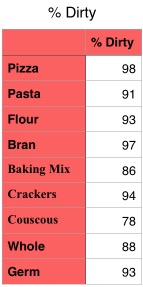
Table-D
And that brings up the this last table with red headers, showing what percentage of which subgroups of wheat contain glyphosate. As one can see, most all of the subgroups have almost 90 percent or above tests proving presence of glyphosate, with the exception of couscous, which has around 80% samples contaminated. This, along with Table-C, also tells you that, for Wheat Bran, near hundred percent (97%) contains glyphosate and average doze of the poison is over a thousand. In short, there is virtually no way one could avoid high glyphosate dose if one consumes Wheat bran.
These last two tables form the basis for the first two graphs. The picture is not pretty.
Thanks for watching and sorry for bringing you gloomy news. I am merely a messenger, and have gone through considerable difficulties to get hold of the raw data from CFIA.
tony mitra
Corn has been conspicuous in the CFIA not by its absence, but by absence of glyphosate from it. We understand most of the corn grown on industrial scale in north America as well as elsewhere may be RoundUp ready and laced with glyphosate. And yet, it shows up with relatively low concentration in comparison with some other crops such as say wheat or chick pea.

Corn story, on around 6,000 CFIA test records
While the reason for this deserves to be investigated separately, the CFIA readings as they stand, can also throw light on country specific data as well as data on which kinds of corn based food shows up with how much glyphosate. The table here is based on country profile from some 250 odd tests done on corn based foods out of about 6,000 total tests from CFIA.
The largest block among countries is, again, unknown. I suspect most of these to be of Canadian origin. Anyhow, the general average glyphosate and AMPA count per sample of corn based food tested by CFIA that originated from Canada or “Unknown” are 3. The country at the top of the list is USA, followed by Italy and Mexico.
USA
For USA, glyphosate starts showing up in some corn starch, and a lot of corn based pre-cooked meal, also often described as called cornmeal in one word.
Italy
In the case of Italy, there are many samples of corn based food with no glyphosate. However, their average seems to have been spoiled by a few cases of food items identified as San Zenone Organic Corn pasta, which show over a hundred ppb. So, in the case of this particular food description, even organic is contaminated. Many other kinds of corn based organic and conventional pasta, such as Penne Rigate, gluten free organic corn pasta – are without glyphosate. However, some but not all of the same Penne Rigate, but without the “organic” in it, has glyphosate.
Mexico
Mexico had a near perfect reading of zero glyphosate in foods originating from there. But it has been spoiled by some corn based foods such as taco shells, tortilla and corn chips.
Canada + Unknown
Among corn based foods from “unknown” and Canada, tortilla, chips, corn flakes and corn bran are among the culprits, having detectable amounts of glyphosate.
Thailand, Philippines & China
Although the sample base is smaller, corn based foods from these countries as tested by CFIA appear to contain no measurable glyphosate or AMPA at all. Out of these, China’s story could be controversial since it is a heavy producer and consumer of glyphosate laced food. We are told that China also grows smaller quantities of organic food and is very careful in ensuring that only organic stuff is exported so that their market and reputation is not spoilt.
Glyphosate Screen Positive
Apart from all above, a large number of glyphosate screen test shows positive (as against negative) for many food types and that includes corn. Most of the positive results come from samples originating from the US, with much lesser numbers from other nations.
You can check a short pdf list of Glyphosate Screen positive items on a related issue – flours made from beans, by clicking here. It also shows the high prevalence of such samples originating from the United States.
Thats it for now.
A friend had made a comment based on an earlier Facebook post of mine about glyphosate in beans from the CFIA test records. That post showed a high presence of glyphosate (+AMPA), showing concern about Mung Beans, which had higher average glyphosate (+AMPA) count than many other types of beans.
Well, we too use Mung Beans at home. We had two varieties. One was organic sprouting Mung Beans – mostly from Mum’s (Canada) and I suspected they’d be very clean. But this was in smaller quantity and I used them only for eating sprouts.
The larger amount was used by the wife for making dal, or lentil soup Dal has been a favourite staple of mine, to be had with rice, as a source of protein, helping to stay away from factory farmed animals.
So I looked into the individual tests of each Mung Bean, to prepare this table, and sorted according to origin of the Mung Bean sample. All readings are in ppb.
India – presumably the largest producer and consumer of Mung Beans, is totally missing from this table. So, either Canada imports no Mung Beans from Canada, or somehow they have not been tested. I shall look further into this later on. However, I have been told by some notables in Canada, that some Indian farmers have started growing lentils in Canada, using industrial methods (i.e. desiccated with glyphosate) for export back to India because India’s constantly rising demand is overtaking its local production. If that is true, then Indian’s might be getting more of Canadian toxic Mung Beans than Canadians getting any Indian variety. Anyhow, I intend to look into the Mung Bean packages next time I visit a store.
Thailand – all their food has so far been very clean, and Mung Bean is no exception. Therefore, if it is not certified organic, but an import from Thailand, you may still be fairly sure that it is clean as far as glyphosate in concerned.
China – this has been a puzzle throughout the CFIA test records. China is the largest producer and exporter of glyphosate as well local consumer. But, as I-Wan-Chen has informed us, they also grow smaller quantity of organic food and has been careful in exporting only the cleaner varieties of food in order not to lose export market. Also, many importers actually visit Chinese farms and take samples of export-crops directly for their own tests. So, if the Mung Bean is from China and being sold in Canada, be cautious but you might be safe here.
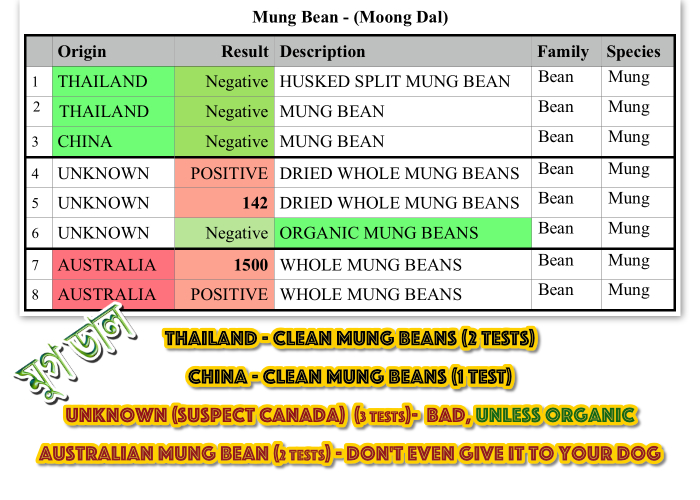
Unknown – I suspect these are either all Canadian, or Canadian + US. Anyhow, these are no good, except if it is certified organic. In other words, if you are not sure where the Mung Bean came from, and if it is not organic – my advise is to stay away. If it is organic – go ahead and buy it.
Austalia – if you find Australian Mung Beans – don’t even give it to your dog.
Also, if anybody living in India is reading this – be extremely careful of buying any Mung Beans imported from Canada/USA or Australia. In general, if it is an English Speaking Anglo-Saxon nation – You may watch their movies, or their sports on TV, but don’t eat their Mung Beans.